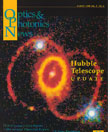
August 1994 Issue
Feature Articles
Optical Transparency: A New Paradigm For Telecommunications
The stage is set for a paradigm shift in telecommunications. For example, new technologies such as optical fiber amplifiers are migrating toward an ever greater capability. Fiber lasers, filters, correlators, and switches are also being developed, while contactless connectors, active leaky feeders, and optical wireless are more recent arrivals on the scene. In addition, fibers can now be "programmed" to display new features crucial to future networking, e.g., gratings written in the core that render the fiber wavelength dependent. Such devices will enable fiber networks to use combinations of wavelength and coded signals for routing and managing traffic.
by Peter Cochrane, Roger Heckingbottom, and David HeatleyWho? Discovered Coddington's Equations?
In these formulae, s and t represent the distances from the point of incidence of the traced ray to the sagittal and tangential object or image, measured along the traced principal ray, and r is the radius of curvature of the refracting surface. Angles I and I' are the angles of incidence and refraction of the principal ray while n and n' are the refractive indices of the object and image spaces.
by Rudolf KingslakeHubble's Corrective Mirrors: Pushing The Optics Envelope
The Hubble Repair Mission provides important lessons in engineering management and project oversight. The following article describes how one NASA subcontractor succeeds.
by Robert J. Aronno and Daniel J. BajukTotal Internal Reflection: Experiments For Kids
I can remember when rotary phones were the norm and we had to fuss with big rabbit-eared antennas to unfuzz our television picture. Some of us are old enough (though I'm not) to even remember what life was like when televisions were a luxury. Technological advances make old technology obsolete. And it's happening faster and faster. Ask any 11-year-old what their favorite Nintendo game is, and "Pong" (popular in the mid-1970s) will probably not be the answer.
by Josh CobbHubble Space Telescope: Mission Update
The data collected from the Hubble Space Telescope (HST) today is of such good quality that researchers are solving 25- to 30-year-old astrophysical questions with as few as one photograph. For example, Figure 1 shows the HST image of the compact blue cluster at the center of the giant ionized hydrogen region 30 Doradus (the Tarantula nebula). For 25 years, astronomers have written research papers about the star at the center of this gigantic nebula in the Large Magellanic Cloud. Some even said that it could be a single object of 3000 solar masses. The first to show that this was possibly a compact cluster was G. Weigelt1 and G. Baier who found eight stars within a diameter of one arcsec. They took 8000 holographic speckle interferograms using two telescopes at the European Southern Observatory in Chile and, after considerable computer processing, were able to show a reconstructed image with resolution 0.09 arcsec.
by H. John Wood

![A multiplexed image of a human tonsil acquired. [NIAID] using the iterative bleaching extends multiplexity (IBEX) method.](https://opnmedia.blob.core.windows.net/$web/opn/media/images/articles/2024/0424/departments/202404-cover-web.jpg?ext=.jpg)
